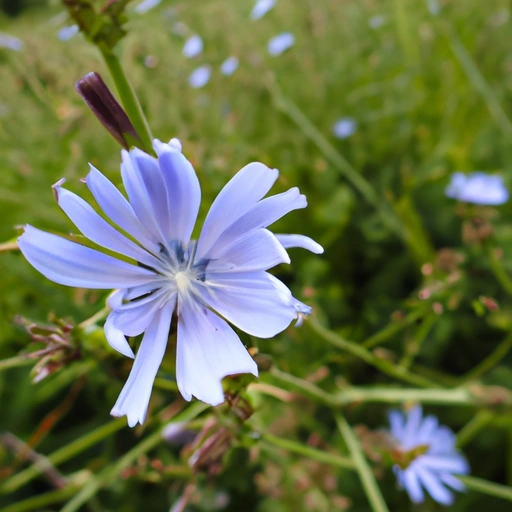Chicory
Description

Chicory is a perennial herbaceous plant of the dandelion family, typically with bright blue flowers. Many varieties are cultivated for salad leaves, chicons (blanched buds), or roots (var. sativum), which are baked, ground, and used as a coffee substitute and food additive. Chicory's leaves are also used in salads, and its roots are often ground into a powder and used as an ingredient or dietary supplement.
Common uses
Chicory is used for its leaves, roots, and buds. The leaves can be eaten raw in salads or cooked like spinach. The roots may be baked, ground, and added to coffee or consumed on their own. Young chicory buds, also known as chicons, are used in a specialty dish called Belgian endive.
Nutritional value
Calories
Chicory root contains approximately 72 calories per 100 grams (3.5 oz).
Protein
It provides about 1.4 grams of protein per 100 grams (3.5 oz).
Fat
Chicory is low in fat, with around 0.2 grams per 100 grams (3.5 oz).
Carbohydrates
Chicory root is high in carbohydrates, with about 17.51 grams per 100 grams (3.5 oz).
Vitamins
Chicory is a good source of vitamins, particularly vitamin A and B-vitamins like folate.
Minerals
It also contains minerals such as manganese, copper, and zinc.
Health benefits
Chicory root is rich in inulin, a type of prebiotic fiber that promotes digestive health and helps improve gut flora. Its leaves have a mild laxative effect and can aid in digestion. Chicory may also help regulate blood sugar levels and contribute to heart health.
Potential risks
Possible risks include allergic reactions in people sensitive to plants in the Asteraceae family. Overconsumption of chicory root extract may lead to digestive discomfort for some individuals due to its high inulin content.
Common recipes
Chicory is featured in a variety of recipes, from the classic New Orleans-style chicory coffee to Belgian endives wrapped in ham. It's also found in Italian-style chicory and white bean soup and as a salad green in French and Mediterranean cuisines.
Cooking methods
Chicory can be sautéed, grilled, baked, or served raw. The roots are often ground and used to flavor or extend coffee.
Pairing with other ingredients
Chicory pairs well with flavors such as garlic, lemon, balsamic vinegar, and most cheeses. It complements fatty meats like bacon or duck and can be incorporated into grain dishes or used as a topping for pizzas and flatbreads.
Summary
Chicory is a versatile food ingredient with a rich history and numerous culinary applications. It provides various health benefits, primarily through its inulin content, and can be used in both sweet and savory dishes. While its use as a coffee substitute is well-known, its leaves and buds also offer unique flavors and textures that enhance a variety of recipes. With its nutritional value and manifold culinary uses, chicory is a valuable addition to any kitchen around the globe.